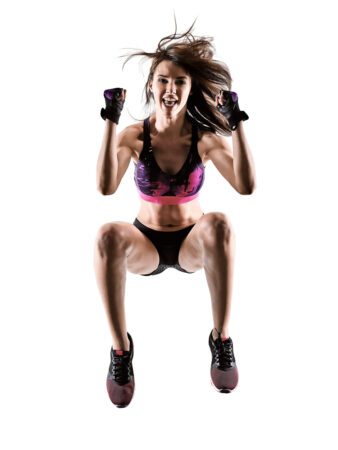 If you’re about to embark on a fitness regimen, you may be considering the benefits of HIIT Vs. steady-state cardio and want to know which will be best for you.
If you’re about to embark on a fitness regimen, you may be considering the benefits of HIIT Vs. steady-state cardio and want to know which will be best for you.
The reality is that you can benefit from doing either or both.
For those unsure about the differences between the two, cardio HIIT workouts are far more challenging than steady-state cardio.
Sessions usually last from 10 to 30 minutes, with 20 minutes typical. During this time, you will train at maximum intensity for short periods, interspersed with periods of rest or low-intensity circuits.
Steady-state cardio workouts are generally low-impact and far less taxing, so anyone can do them.
The pace is slow to moderate throughout the workout, enabling you to train for longer without exhausting yourself.
Examples include long walks or runs, exercising on a rowing machine or exercise bike, and swimming laps in a pool.
In this HIIT Vs. steady-state cardio article, we will look at the positives and negatives of each to help you make an informed decision about which will be best for you.
Table of Contents
HIIT Vs. Steady-State Cardio Benefits and Drawbacks
HIIT is best for burning fat, while steady-state cardio is good for maintaining muscle gained through strength training, but both can benefit your health and fitness in other ways, too.
For example, the endurance and stamina you build with HIIT can improve other aspects of your life. This could be finding it easier to run a 5k race or lift more weight at the gym.
HIIT workouts take less time than Steady-state cardio, burn more calories, and increase muscle strength.
Both can improve lower blood pressure, improve cardiovascular health and lower the risk of diabetes and stroke.
Steady-state cardio workouts are safe to do daily.
HIIT workouts are intense, so they come with overuse and injury risks. For this reason, you should take at least one day’s break between sessions to allow your body to rest and recuperate.
If quick results are your goal, alternating the two types of exercise will give you the benefits of both.
Which is Right for You?
Your answers to the following questions will help you determine whether cardio HIIT workouts or steady-state cardio workouts will suit you best.
-
How much do you Weigh?
The more you weigh, the less likely it is that cardio HIIT workouts will be right for you. This is because the impact of HIIT can cause pain and stress your joints. It could also result in injury.
Start with steady-state cardio workouts and undertake a weight loss diet if you are overweight.
After losing weight and improving your fitness level, try incorporating some HIIT into your workout regimen.
Doing so will help you shed your remaining excess pounds quickly, and your body will better handle the impact of the workouts when you have some conditioning.
-
What is your current fitness level?
HIIT should only be undertaken by people who already have a degree of fitness. If you haven’t exercised before or not for a long time, it will not be for you.
At the least, you would experience severe delayed onset muscle soreness the day after your first HIIT workout, preventing you from exercising for days.
You could even injure yourself, in which case you would be sidelined for even longer.
For such people, steady-state cardio workouts are the better option.
After doing steady-state cardio for a month or two, gradually include some short HIIT sessions in your workout.
Over time, increase the time you spend doing HIIT and the intensity of your sessions.
-
How much time do you have to exercise?
If your body can handle it, HIIT is one of the most efficient forms of exercise you can do.
Ideal for busy people, regular short sessions will tone your body and get you into shape fast.
HIIT is also excellent for improving stamina.
-
When can you train?
While you can benefit from doing HIIT at any time, some experts say that the best results come from early morning sessions.
The reasoning is that your body will continue to burn fat throughout the rest of the day if you work out early. This type of exercise is known as a fasted cardio workout.
If you can only exercise in the evenings, HIIT workouts may affect your sleep. This is due to the spike in energy that many people notice after recovering from the workout.
So if you can only work out at night, you may be better off doing steady-state cardio workouts.
Though opinions differ, many fitness trainers agree that cardio HIIT workouts should not be undertaken on an empty stomach.
If you decide to train upon waking, do a light training session and see how you feel.
If you feel weak or sick, try eating something light like a banana or having a protein shake thirty minutes or so before your workout.
-
Do you have any existing injuries or health issues?
HIIT is a training protocol for people who are already reasonably fit.
If you are unsure your body will cope, speak to your doctor before doing HIIT or any other exercise program.
This is particularly important for anyone with joint problems, a heart condition, and those who are overweight.
-
What is your pain threshold?
The goal of exercise is to improve your health and fitness.
HIIT is very challenging. Some people may find it too demanding and exhausting, despite the workouts being short.
If you find yourself making excuses to skip your workouts or you’re always thinking about how much you hate them, give HIIT a miss and stick with steady-state cardio.
HIIT Vs. Steady-State Cardio Summary
I hope this HIIT Vs. steady-state cardio article has given you an idea of which workout will be right for you. 
The bottom line is this: both HIIT and steady-state cardio workouts have benefits and drawbacks.
If your goal is weight loss or toning up, then HIIT may be right for you.
If gaining strength or endurance are on your list of priorities, then steady state cardio might be more beneficial in the long run.
If you stay active and are consistent with your workouts, you will be able to improve your fitness and lose weight by doing steady-state cardio workouts.
Once you’re fitter, you can slowly challenge yourself with short cardio HIIT workouts. In the meantime, do what is right for you now.
Click this link for more information on HIIT cardio workouts and the associated benefits.
Click here to find out 5 of the best moves to add to your HIIT fat-burning workouts.

